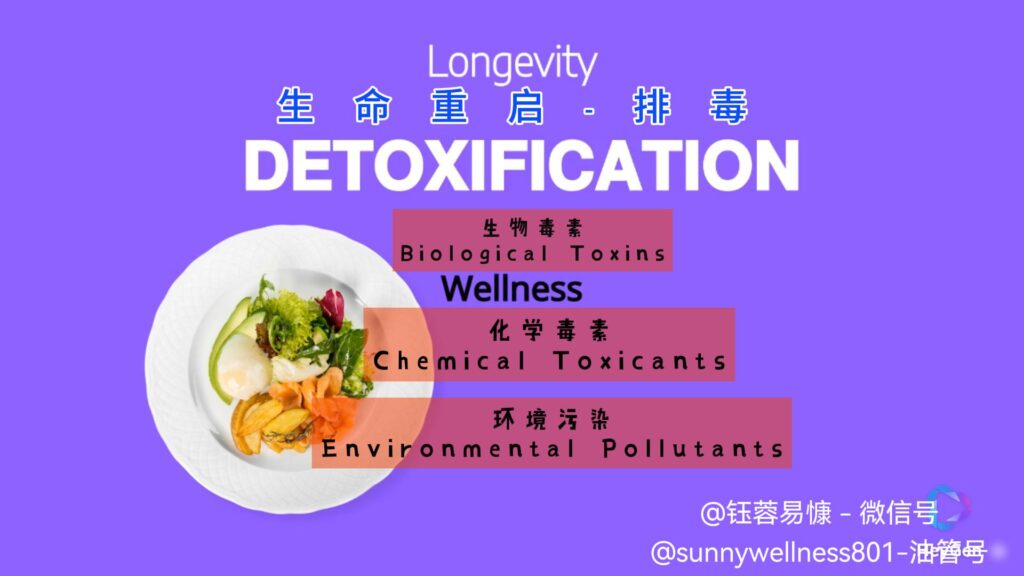
Toxins and Toxicants
A popular term in the wellness industry today is “detox.” As someone who has worked in the medical and pharmaceutical fields for many years, I initially didn’t quite understand what toxins we needed to detox from our bodies. However, through long-term practice and learning in the fields of anti-aging and health nutrition, I have gained a lot of new knowledge. I hope this information can be helpful to everyone. Here is a summary.
Exposure to Toxins
The human body naturally produces toxins during its routine functions and is also exposed to environmental pollutants in the air, drinking water, and food supply. Fortunately, the body has an efficient metabolic detoxification pathway that neutralizes and removes harmful chemicals through key elimination channels, including the digestive system, liver, and kidneys.
1. Toxins and Toxicants:
- Toxins: Compounds produced by living organisms (such as bacteria, fungi, plants, and animals) that are harmful to humans.
- Toxicants: Toxic chemicals found in nature, made or synthesized by humans (such as pesticides, heavy metals, and industrial chemicals).
Both toxins and toxicants can damage cells, tissues, and organs. Exposure to these harmful substances is increasing, and this issue is compounded by the fact that much of the nutritional value of our food has been refined away and replaced with artificial colorings, preservatives, flavorings, and conditioners.
2. Categories of Toxins and Toxicants:
- Biological Toxins: Produced by living organisms.
- Bacterial Toxins: Such as botulinum toxin causing botulism. Tetanus Toxin causing tetanus. Cholera Toxin causing cholera.
- Fungal Toxins (Mycotoxins): Aflatoxins found in contaminated food and Ochratoxins: Produced by Aspergillus and Penicillium
- Plant Toxins: Like ricin from castor beans. Ricin: Found in castor beans. Atropine: Found in deadly nightshade.
- Animal Toxins: Venoms from snakes and spiders. Tetrodotoxin: Found in pufferfish.
- Chemical Toxicants: Found in nature or created by human activity.
- Heavy Metals: Lead can cause neurological damage, especially in children. Mercury: Affects the nervous system and is highly toxic
- Industrial Chemicals: Asbestos: A fibrous mineral causing lung diseases.
- Persistent Organic Pollutants (POPs): Such as dioxins, Polychlorinated Biphenyls (PCBs): Used in electrical equipment, linked to cancer.
- Environmental Pollutants: Synthetic Toxicants also called xenobiotics and made by human these toxicants enter the body through the skin, lungs, and intestinal tract. Many of these compounds are lipid-soluble, allowing them to readily accumulate in body tissues.
- Pharmaceuticals: Some drugs can become toxic at high doses or due to metabolic idiosyncrasies.
- Paracetamol (Acetaminophen): Overdose can lead to liver damage.
- Organophosphates: Affect the nervous system by inhibiting acetylcholinesterase.
- Chemical Warfare Agents:
- Sarin: A nerve agent that inhibits acetylcholinesterase.
- Mustard Gas: Causes severe blistering and respiratory damage.
- Volatile Organic Compounds (VOCs): Chemicals used in industrial processes and found in household products.
- Pesticides: DDT: DDT (dichlorodiphenyltrichloroethane) is an organochlorine pesticide that has been banned due to its high environmental stability and resistance to degradation. It tends to persist for a long time in soil, water, and living organisms. Prolonged exposure to DDT can lead to reproductive issues, immune system damage, and other chronic health problems.
- Air Pollutants: Carbon Monoxide (CO): A colorless, odorless gas that impairs oxygen delivery.
- Particulate Matter: Small particles that can penetrate deep into the lungs.
- Water Pollutants: Arsenic: Naturally occurring in groundwater, can cause skin and internal cancers. Fluoride: In excess, can cause skeletal fluorosis.
3. Toxic Burden
Toxic burden refers to the total accumulation of toxins in your body. Over time, the buildup of harmful chemicals from the environment and lifestyle choices can compromise bodily functions and negatively impact your health. Understanding the sources and types of toxins and toxicants can help us take steps to minimize exposure and support the body’s natural detoxification processes.
By being aware of the sources and effects of these toxins, you can better protect your health and reduce your toxic burden.
